HLT-364 GCU Report: Effects of Ineffective Discharge Planning
VerifiedAdded on 2021/04/21
|6
|1073
|467
Report
AI Summary
This report, authored by Ashley Ballesteros, investigates the critical effects of ineffective discharge planning in healthcare settings. It highlights how poor discharge strategies lead to adverse outcomes, including increased patient readmissions, prolonged hospital stays, and higher healthcare costs. The report emphasizes the importance of proper discharge planning in improving patient care, reducing financial burdens, and enhancing overall healthcare quality. It explores the impact on various stakeholders, including patients, healthcare providers, and family members. The report also underscores the significance of communication, documentation, and coordination in ensuring a smooth and effective discharge process. It references several sources to support its findings and concludes with a call for improved discharge planning practices to ensure patient safety and well-being. This assignment is available on Desklib, a platform offering study resources.
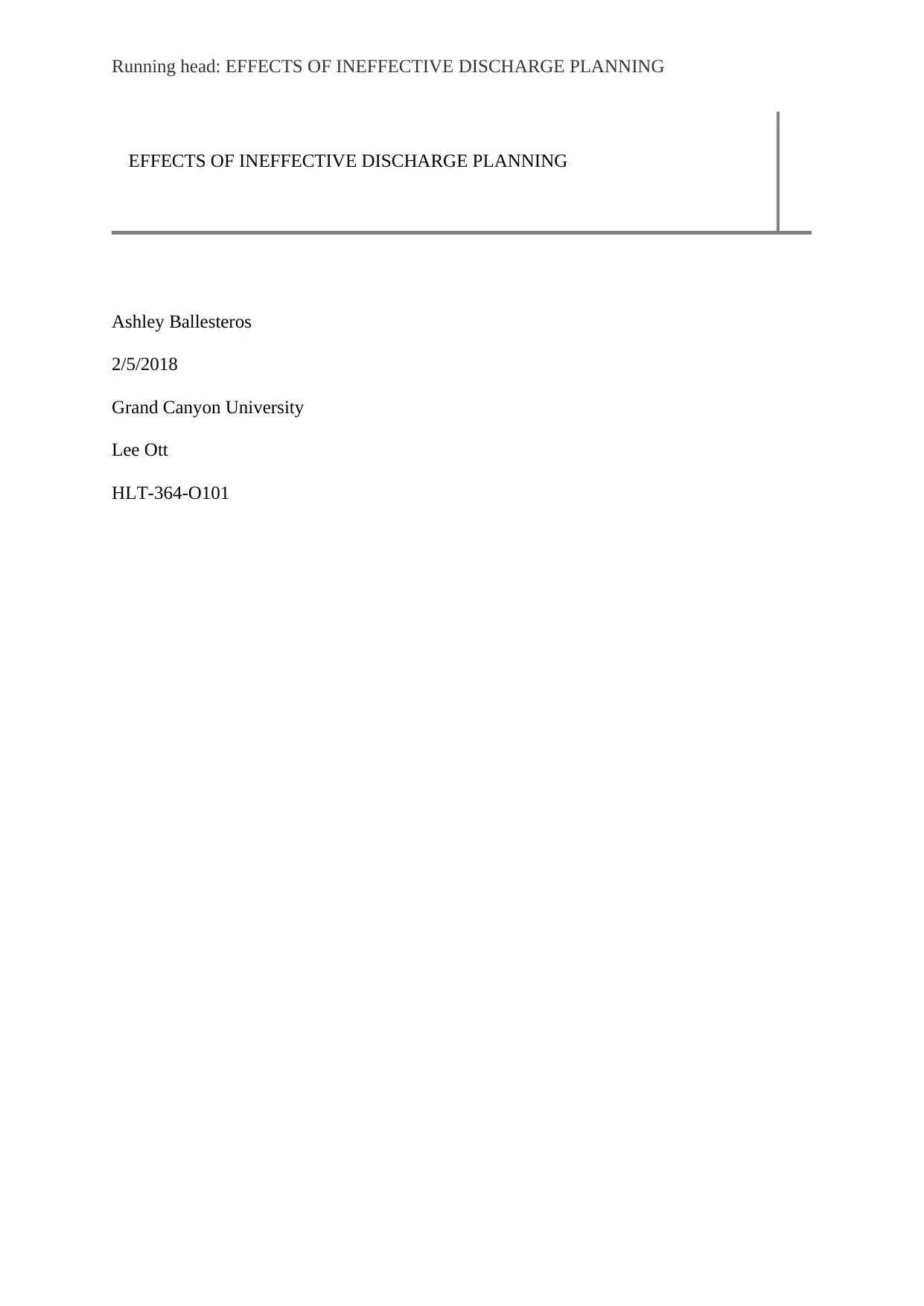
Running head: EFFECTS OF INEFFECTIVE DISCHARGE PLANNING
EFFECTS OF INEFFECTIVE DISCHARGE PLANNING
Ashley Ballesteros
2/5/2018
Grand Canyon University
Lee Ott
HLT-364-O101
EFFECTS OF INEFFECTIVE DISCHARGE PLANNING
Ashley Ballesteros
2/5/2018
Grand Canyon University
Lee Ott
HLT-364-O101
Paraphrase This Document
Need a fresh take? Get an instant paraphrase of this document with our AI Paraphraser
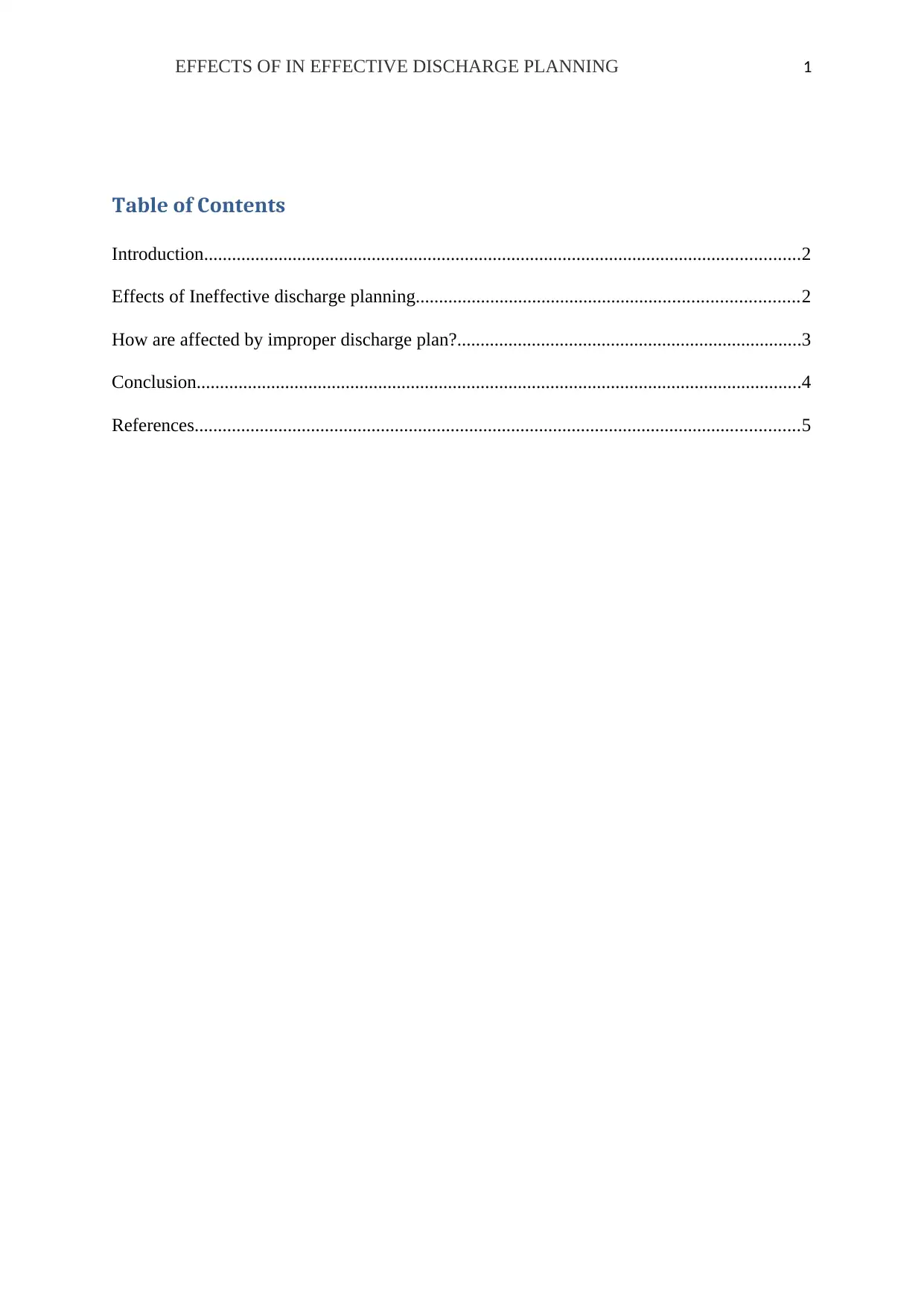
EFFECTS OF IN EFFECTIVE DISCHARGE PLANNING 1
Table of Contents
Introduction................................................................................................................................2
Effects of Ineffective discharge planning..................................................................................2
How are affected by improper discharge plan?..........................................................................3
Conclusion..................................................................................................................................4
References..................................................................................................................................5
Table of Contents
Introduction................................................................................................................................2
Effects of Ineffective discharge planning..................................................................................2
How are affected by improper discharge plan?..........................................................................3
Conclusion..................................................................................................................................4
References..................................................................................................................................5
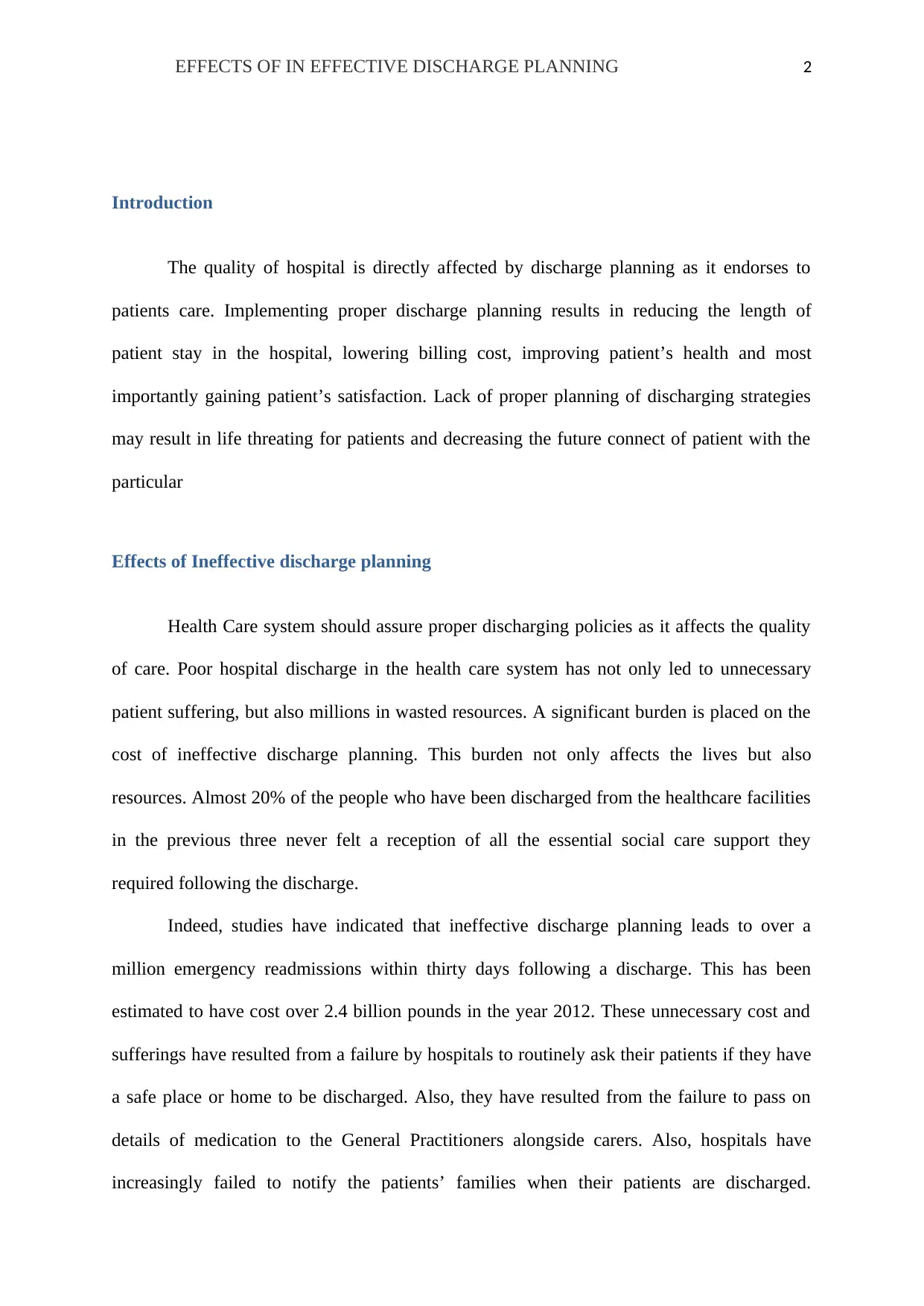
EFFECTS OF IN EFFECTIVE DISCHARGE PLANNING 2
Introduction
The quality of hospital is directly affected by discharge planning as it endorses to
patients care. Implementing proper discharge planning results in reducing the length of
patient stay in the hospital, lowering billing cost, improving patient’s health and most
importantly gaining patient’s satisfaction. Lack of proper planning of discharging strategies
may result in life threating for patients and decreasing the future connect of patient with the
particular
Effects of Ineffective discharge planning
Health Care system should assure proper discharging policies as it affects the quality
of care. Poor hospital discharge in the health care system has not only led to unnecessary
patient suffering, but also millions in wasted resources. A significant burden is placed on the
cost of ineffective discharge planning. This burden not only affects the lives but also
resources. Almost 20% of the people who have been discharged from the healthcare facilities
in the previous three never felt a reception of all the essential social care support they
required following the discharge.
Indeed, studies have indicated that ineffective discharge planning leads to over a
million emergency readmissions within thirty days following a discharge. This has been
estimated to have cost over 2.4 billion pounds in the year 2012. These unnecessary cost and
sufferings have resulted from a failure by hospitals to routinely ask their patients if they have
a safe place or home to be discharged. Also, they have resulted from the failure to pass on
details of medication to the General Practitioners alongside carers. Also, hospitals have
increasingly failed to notify the patients’ families when their patients are discharged.
Introduction
The quality of hospital is directly affected by discharge planning as it endorses to
patients care. Implementing proper discharge planning results in reducing the length of
patient stay in the hospital, lowering billing cost, improving patient’s health and most
importantly gaining patient’s satisfaction. Lack of proper planning of discharging strategies
may result in life threating for patients and decreasing the future connect of patient with the
particular
Effects of Ineffective discharge planning
Health Care system should assure proper discharging policies as it affects the quality
of care. Poor hospital discharge in the health care system has not only led to unnecessary
patient suffering, but also millions in wasted resources. A significant burden is placed on the
cost of ineffective discharge planning. This burden not only affects the lives but also
resources. Almost 20% of the people who have been discharged from the healthcare facilities
in the previous three never felt a reception of all the essential social care support they
required following the discharge.
Indeed, studies have indicated that ineffective discharge planning leads to over a
million emergency readmissions within thirty days following a discharge. This has been
estimated to have cost over 2.4 billion pounds in the year 2012. These unnecessary cost and
sufferings have resulted from a failure by hospitals to routinely ask their patients if they have
a safe place or home to be discharged. Also, they have resulted from the failure to pass on
details of medication to the General Practitioners alongside carers. Also, hospitals have
increasingly failed to notify the patients’ families when their patients are discharged.
⊘ This is a preview!⊘
Do you want full access?
Subscribe today to unlock all pages.

Trusted by 1+ million students worldwide
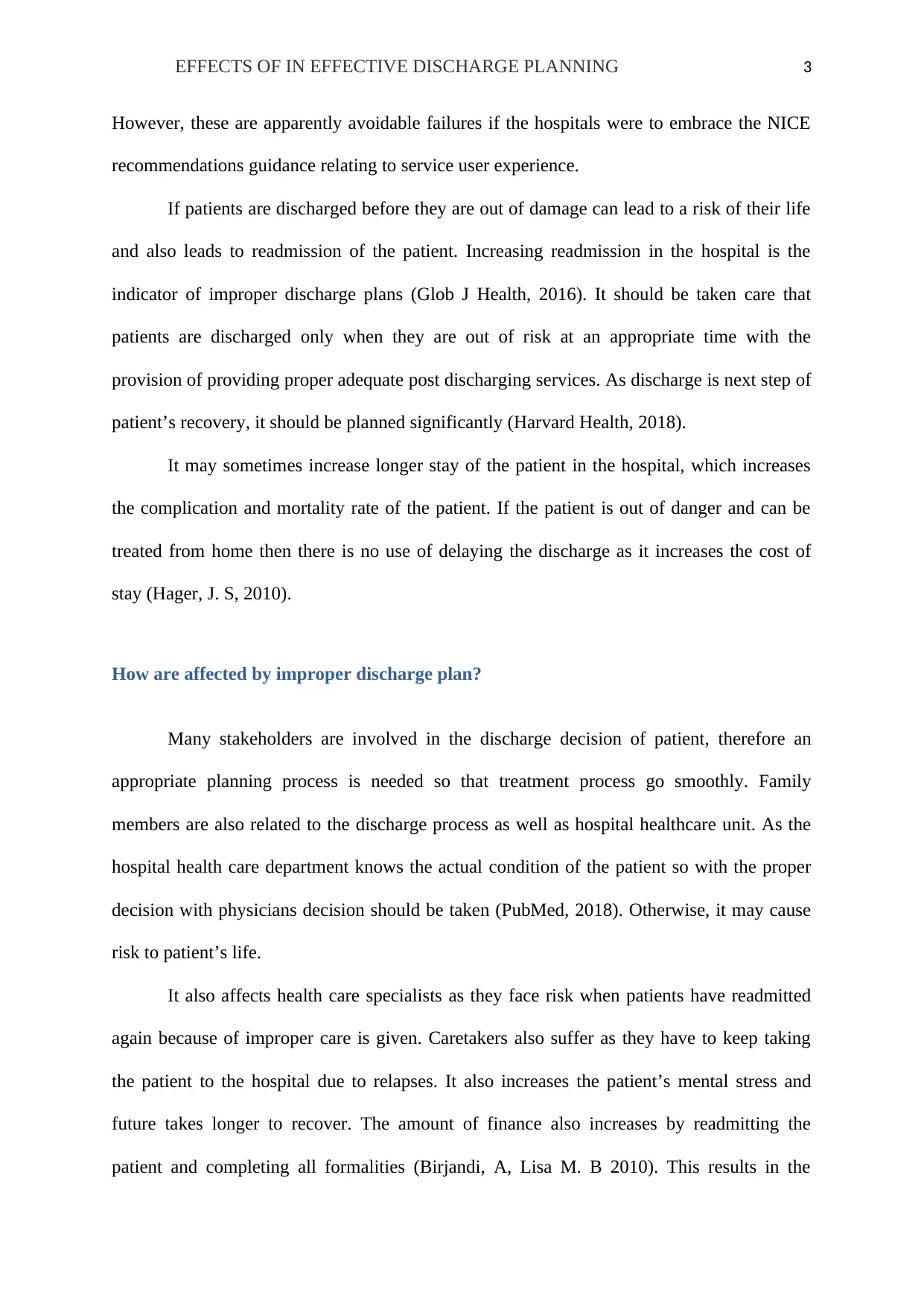
EFFECTS OF IN EFFECTIVE DISCHARGE PLANNING 3
However, these are apparently avoidable failures if the hospitals were to embrace the NICE
recommendations guidance relating to service user experience.
If patients are discharged before they are out of damage can lead to a risk of their life
and also leads to readmission of the patient. Increasing readmission in the hospital is the
indicator of improper discharge plans (Glob J Health, 2016). It should be taken care that
patients are discharged only when they are out of risk at an appropriate time with the
provision of providing proper adequate post discharging services. As discharge is next step of
patient’s recovery, it should be planned significantly (Harvard Health, 2018).
It may sometimes increase longer stay of the patient in the hospital, which increases
the complication and mortality rate of the patient. If the patient is out of danger and can be
treated from home then there is no use of delaying the discharge as it increases the cost of
stay (Hager, J. S, 2010).
How are affected by improper discharge plan?
Many stakeholders are involved in the discharge decision of patient, therefore an
appropriate planning process is needed so that treatment process go smoothly. Family
members are also related to the discharge process as well as hospital healthcare unit. As the
hospital health care department knows the actual condition of the patient so with the proper
decision with physicians decision should be taken (PubMed, 2018). Otherwise, it may cause
risk to patient’s life.
It also affects health care specialists as they face risk when patients have readmitted
again because of improper care is given. Caretakers also suffer as they have to keep taking
the patient to the hospital due to relapses. It also increases the patient’s mental stress and
future takes longer to recover. The amount of finance also increases by readmitting the
patient and completing all formalities (Birjandi, A, Lisa M. B 2010). This results in the
However, these are apparently avoidable failures if the hospitals were to embrace the NICE
recommendations guidance relating to service user experience.
If patients are discharged before they are out of damage can lead to a risk of their life
and also leads to readmission of the patient. Increasing readmission in the hospital is the
indicator of improper discharge plans (Glob J Health, 2016). It should be taken care that
patients are discharged only when they are out of risk at an appropriate time with the
provision of providing proper adequate post discharging services. As discharge is next step of
patient’s recovery, it should be planned significantly (Harvard Health, 2018).
It may sometimes increase longer stay of the patient in the hospital, which increases
the complication and mortality rate of the patient. If the patient is out of danger and can be
treated from home then there is no use of delaying the discharge as it increases the cost of
stay (Hager, J. S, 2010).
How are affected by improper discharge plan?
Many stakeholders are involved in the discharge decision of patient, therefore an
appropriate planning process is needed so that treatment process go smoothly. Family
members are also related to the discharge process as well as hospital healthcare unit. As the
hospital health care department knows the actual condition of the patient so with the proper
decision with physicians decision should be taken (PubMed, 2018). Otherwise, it may cause
risk to patient’s life.
It also affects health care specialists as they face risk when patients have readmitted
again because of improper care is given. Caretakers also suffer as they have to keep taking
the patient to the hospital due to relapses. It also increases the patient’s mental stress and
future takes longer to recover. The amount of finance also increases by readmitting the
patient and completing all formalities (Birjandi, A, Lisa M. B 2010). This results in the
Paraphrase This Document
Need a fresh take? Get an instant paraphrase of this document with our AI Paraphraser
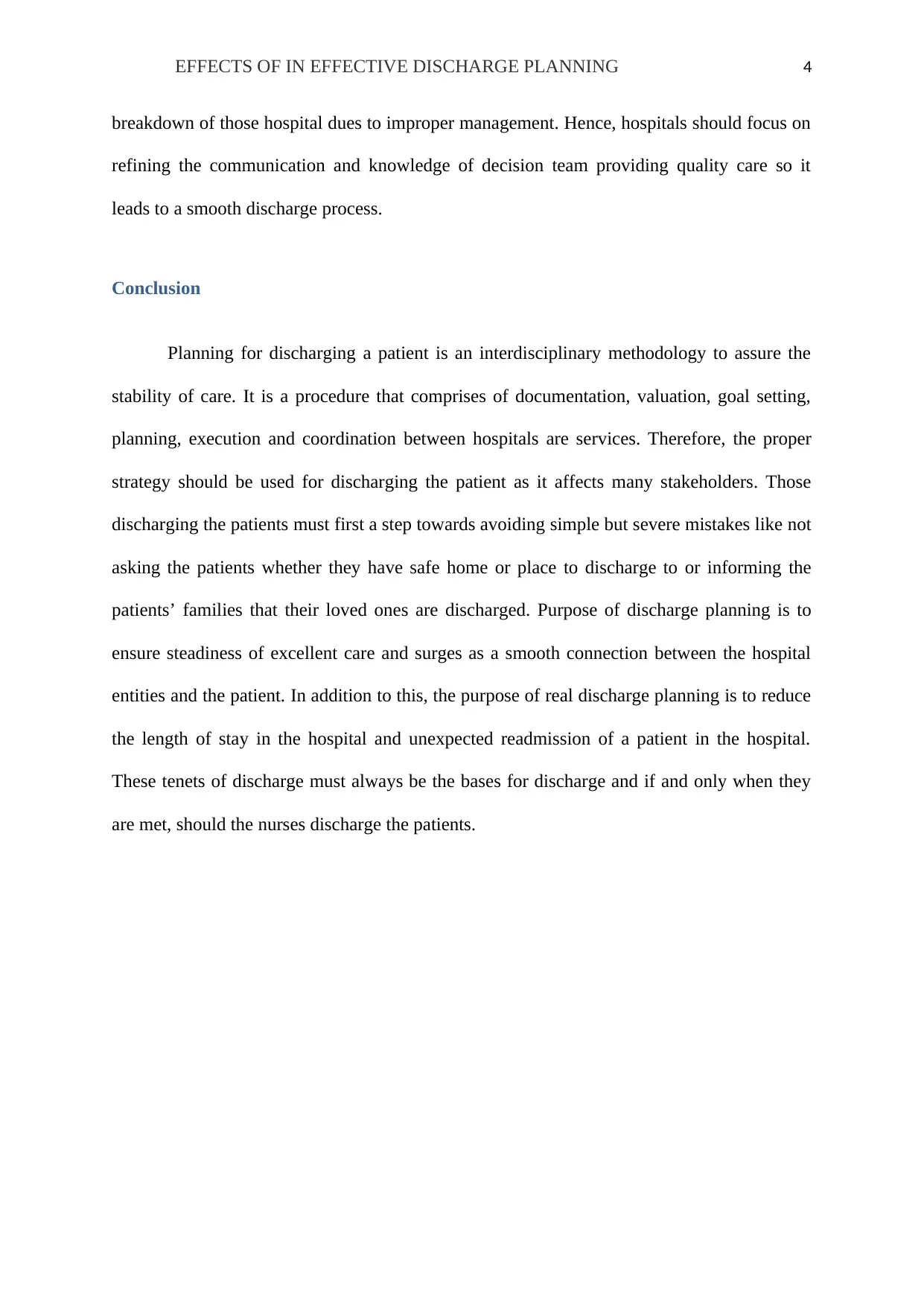
EFFECTS OF IN EFFECTIVE DISCHARGE PLANNING 4
breakdown of those hospital dues to improper management. Hence, hospitals should focus on
refining the communication and knowledge of decision team providing quality care so it
leads to a smooth discharge process.
Conclusion
Planning for discharging a patient is an interdisciplinary methodology to assure the
stability of care. It is a procedure that comprises of documentation, valuation, goal setting,
planning, execution and coordination between hospitals are services. Therefore, the proper
strategy should be used for discharging the patient as it affects many stakeholders. Those
discharging the patients must first a step towards avoiding simple but severe mistakes like not
asking the patients whether they have safe home or place to discharge to or informing the
patients’ families that their loved ones are discharged. Purpose of discharge planning is to
ensure steadiness of excellent care and surges as a smooth connection between the hospital
entities and the patient. In addition to this, the purpose of real discharge planning is to reduce
the length of stay in the hospital and unexpected readmission of a patient in the hospital.
These tenets of discharge must always be the bases for discharge and if and only when they
are met, should the nurses discharge the patients.
breakdown of those hospital dues to improper management. Hence, hospitals should focus on
refining the communication and knowledge of decision team providing quality care so it
leads to a smooth discharge process.
Conclusion
Planning for discharging a patient is an interdisciplinary methodology to assure the
stability of care. It is a procedure that comprises of documentation, valuation, goal setting,
planning, execution and coordination between hospitals are services. Therefore, the proper
strategy should be used for discharging the patient as it affects many stakeholders. Those
discharging the patients must first a step towards avoiding simple but severe mistakes like not
asking the patients whether they have safe home or place to discharge to or informing the
patients’ families that their loved ones are discharged. Purpose of discharge planning is to
ensure steadiness of excellent care and surges as a smooth connection between the hospital
entities and the patient. In addition to this, the purpose of real discharge planning is to reduce
the length of stay in the hospital and unexpected readmission of a patient in the hospital.
These tenets of discharge must always be the bases for discharge and if and only when they
are met, should the nurses discharge the patients.
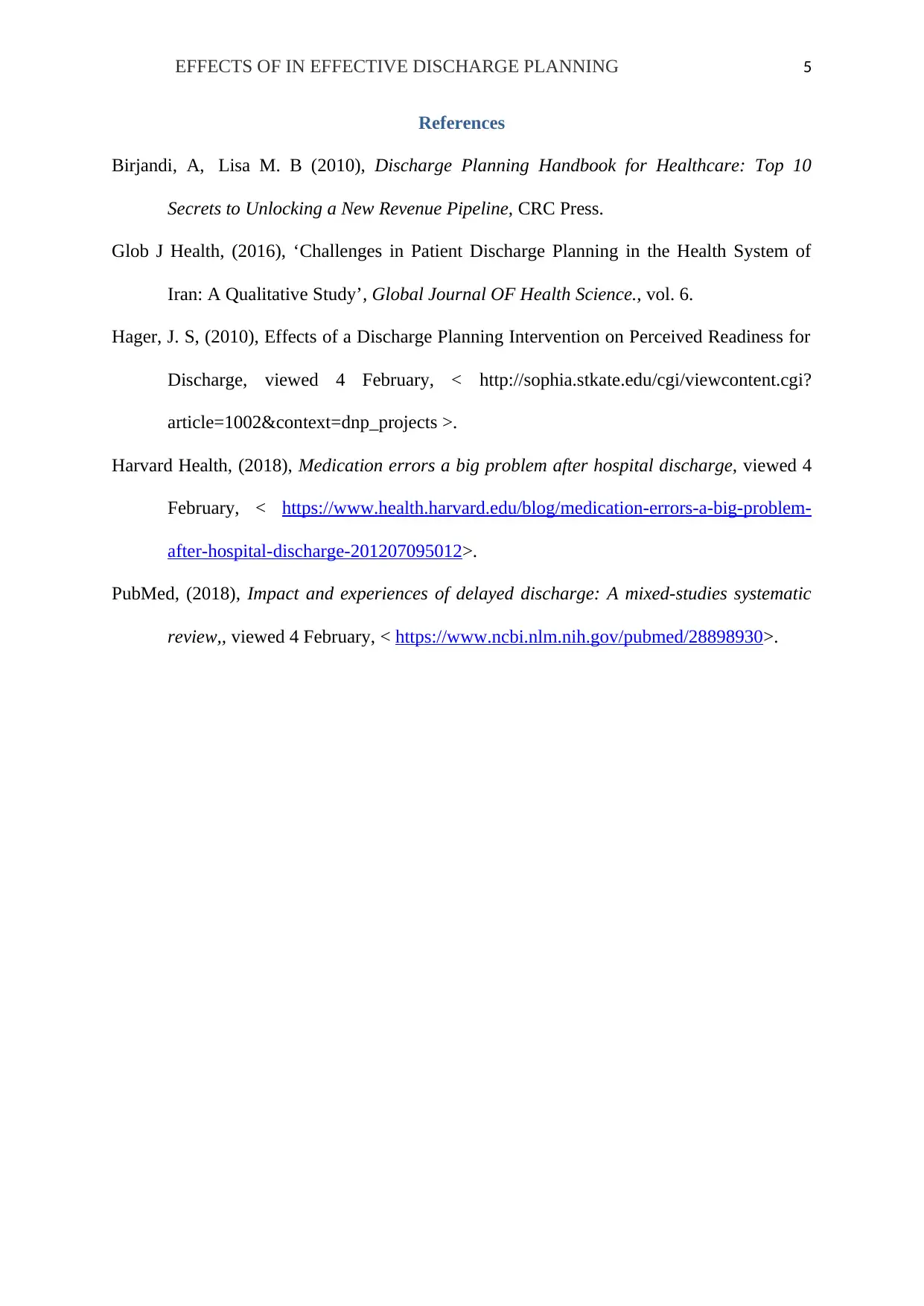
EFFECTS OF IN EFFECTIVE DISCHARGE PLANNING 5
References
Birjandi, A, Lisa M. B (2010), Discharge Planning Handbook for Healthcare: Top 10
Secrets to Unlocking a New Revenue Pipeline, CRC Press.
Glob J Health, (2016), ‘Challenges in Patient Discharge Planning in the Health System of
Iran: A Qualitative Study’, Global Journal OF Health Science., vol. 6.
Hager, J. S, (2010), Effects of a Discharge Planning Intervention on Perceived Readiness for
Discharge, viewed 4 February, < http://sophia.stkate.edu/cgi/viewcontent.cgi?
article=1002&context=dnp_projects >.
Harvard Health, (2018), Medication errors a big problem after hospital discharge, viewed 4
February, < https://www.health.harvard.edu/blog/medication-errors-a-big-problem-
after-hospital-discharge-201207095012>.
PubMed, (2018), Impact and experiences of delayed discharge: A mixed-studies systematic
review,, viewed 4 February, < https://www.ncbi.nlm.nih.gov/pubmed/28898930>.
References
Birjandi, A, Lisa M. B (2010), Discharge Planning Handbook for Healthcare: Top 10
Secrets to Unlocking a New Revenue Pipeline, CRC Press.
Glob J Health, (2016), ‘Challenges in Patient Discharge Planning in the Health System of
Iran: A Qualitative Study’, Global Journal OF Health Science., vol. 6.
Hager, J. S, (2010), Effects of a Discharge Planning Intervention on Perceived Readiness for
Discharge, viewed 4 February, < http://sophia.stkate.edu/cgi/viewcontent.cgi?
article=1002&context=dnp_projects >.
Harvard Health, (2018), Medication errors a big problem after hospital discharge, viewed 4
February, < https://www.health.harvard.edu/blog/medication-errors-a-big-problem-
after-hospital-discharge-201207095012>.
PubMed, (2018), Impact and experiences of delayed discharge: A mixed-studies systematic
review,, viewed 4 February, < https://www.ncbi.nlm.nih.gov/pubmed/28898930>.
⊘ This is a preview!⊘
Do you want full access?
Subscribe today to unlock all pages.

Trusted by 1+ million students worldwide
1 out of 6
Related Documents
Your All-in-One AI-Powered Toolkit for Academic Success.
+13062052269
info@desklib.com
Available 24*7 on WhatsApp / Email
![[object Object]](/_next/static/media/star-bottom.7253800d.svg)
Unlock your academic potential
Copyright © 2020–2025 A2Z Services. All Rights Reserved. Developed and managed by ZUCOL.





